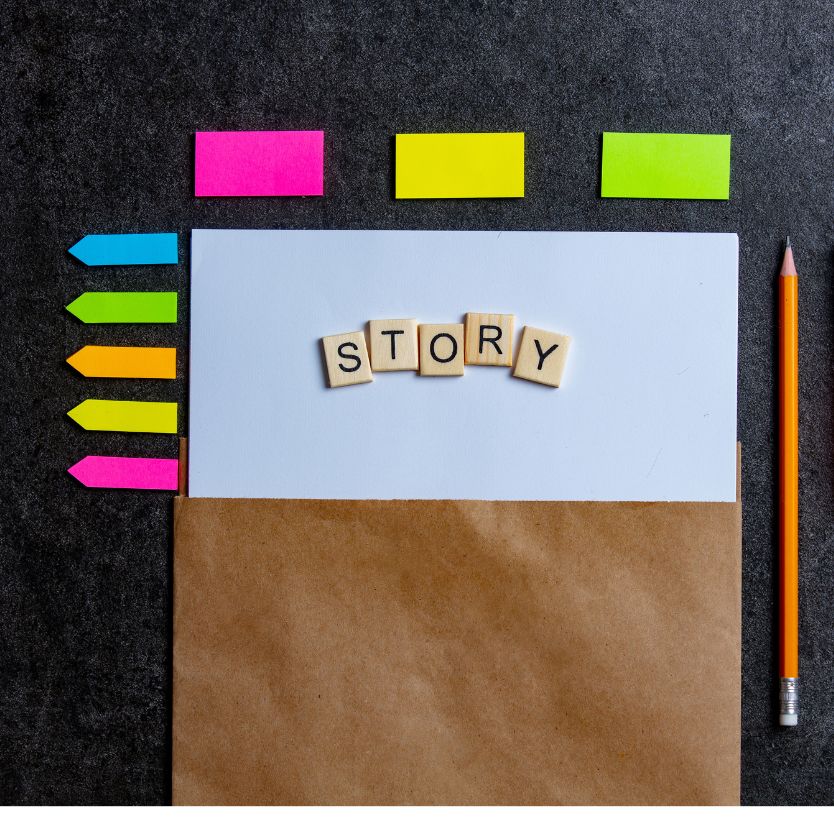People have always had a natural talent for telling stories. It is an essential means of communication and understanding the world, from old stories to contemporary discourse. Everyone has a tale to tell, and putting pen to paper can help you become a better writer and communicator. But what makes a good storyteller? Here are five easy ways to improve your story writing skills.
What is a Story?

At its essence, a story is a connected sequence of events. However, a well-rounded story contains these five essential elements:
- Setting: Where and when the story takes place.
- Plot: The sequence of events in the narrative.
- Conflict: The problem or challenge faced by the characters.
- Characters: The people or beings involved in the story.
- Theme: The underlying message or lesson conveyed.
Famous Examples of Storytelling
Consider Hemingway’s famous six-word story: “For sale: baby shoes, never worn.” Despite its brevity, it prompts the reader to infer the deeper elements such as setting, characters, conflict, and theme.
Another example is “Cosmic Report Card: Earth.” This short story gives a brief yet impactful evaluation of humanity’s existence. The power of storytelling lies in its ability to provoke thought, even with minimal words.
Similarly, “ThingsFromMars.com: A Portal to the Weird and Wonderful” captures the curiosity and imagination of visitors through its creative narrative. The story behind the brand compels readers to explore a world of quirky and unexpected gifts, making it both engaging and memorable.
Types of Stories
According to author Christopher Booker, there are seven basic types of stories:
- Overcoming the Monster
- Rags to Riches
- The Quest
- Voyage and Return
- Rebirth
- Comedy
- Tragedy
Each type follows its narrative arc, but all share core storytelling elements.
Steps to Write a Great Story

1. Find Inspiration
Every great story begins with an idea. Inspiration can come from anywhere—your own experiences, current events, or even a “what if?” scenario. Keep a notebook to jot down ideas as they come to you.
2. Brainstorm
Once you have an idea, start brainstorming. Think of plot ideas, character traits, and possible conflicts. This is where you explore the potential directions your story can take. The more you brainstorm, the clearer your vision becomes.
3. Outline Your Story
Outlining is key to structuring your story. Include the main events in the plot, key character developments, and any essential details. A good outline helps keep your story focused and ensures you cover all necessary elements.
4. Write the First Draft
Now it’s time to write. Don’t worry about perfecting it—just write the story down on paper. Avoid editing as you go. The first draft is all about letting your ideas flow naturally.
5. Revise and Edit
Once your first draft is complete, take a step back. Seek feedback from others, and revise your story based on their input. Afterward, edit for grammar, spelling, and punctuation to ensure your writing is polished and error-free.
Examples of Timeless Stories
Some stories have withstood the test of time. Consider:
- The Tortoise and the Hare: A fable that teaches the value of perseverance over speed.
- Frankenstein by Mary Shelley: A tale exploring the conflict between humanity and nature, filled with timeless themes of life, death, and morality.
Conclusion
By understanding the elements of storytelling and following a structured writing process, you can write a great story. Whether you’re writing a novel or flash fiction, remember that every story starts with a single idea. Embrace your creativity, and let your unique voice shine through your storytelling.
Story Writing FAQs
What is a story?
A story is a connected series of events with key elements like setting, characters, conflict, and theme.
How do stories work?
Stories communicate messages through characters who face conflicts, ultimately leading to resolution or transformation.
What are the different types of stories?
Stories can fall into categories such as overcoming the monster, rags to riches, the quest, voyage and return, rebirth, comedy, or tragedy.

Evelyn Johnson is a creative writer and entrepreneur with over 7 years of experience in the writing industry. As the founder of thingsfrommars.com, she combines creativity and business savvy to craft unique content that captivates audiences. Evelyn specializes in storytelling, corporate writing, and product marketing, sharing her expertise through industry insights. Connect with Evelyn on LinkedIn.





No Comments